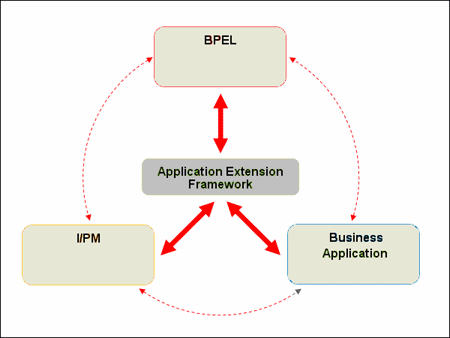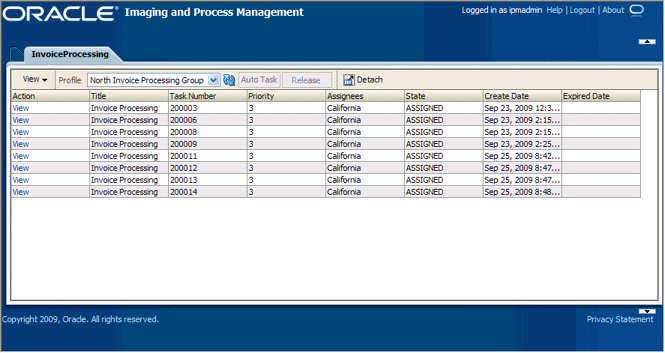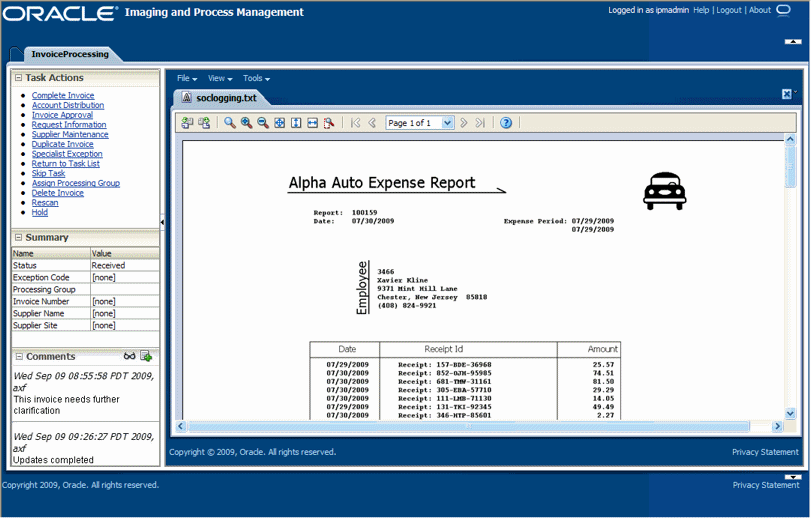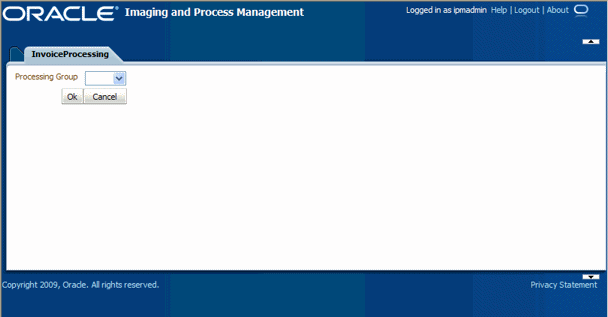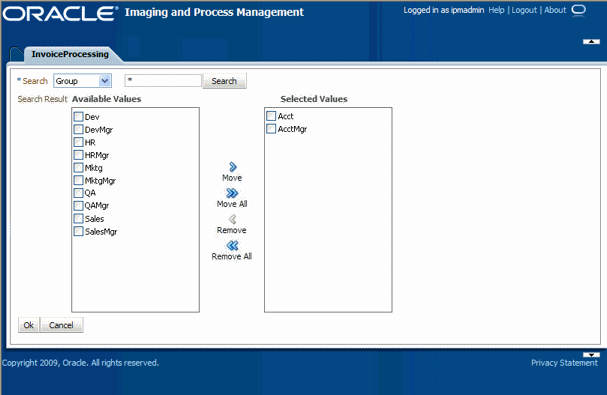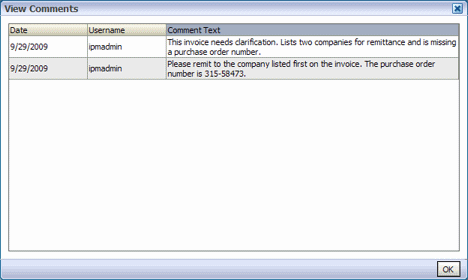1 Solution Overview
This chapter covers the following topics:
1.1 About This Guide
This guide contains the following chapters:
-
Chapter 1, "Solution Overview," introduces AXF components, the imaging solution, security and authentication, and adapter system requirements.
-
Chapter 2, "Configuring PeopleSoft Components," describes how to configure AXF components on PeopleSoft pages.
-
Chapter 3, "Configuring Imaging Solution Components," describes how to configure the BPEL Connection for the imaging solution.
-
Chapter 4, "Imaging Solution Tables," describes the AXF and PeopleSoft configuration tables used for the Imaging Solution, including commands and web user interface tools, and provides example implementations.
1.2 About Application Extension Framework (AXF)
Oracle's Application Extension Framework (AXF) is a command-driven, web services integration between a business application such as PeopleSoft and a content management application such as Oracle Imaging and Process Management (Oracle I/PM). The open Java-based architecture of AXF allows integrators to configure and modify multiple business process solutions separate from the systems themselves, and to upgrade systems without affecting implemented AXF solutions.
The Application Extension Framework includes the following components:
Oracle provides templates for specific functions, such as automating invoice and receipt processing using BPEL-based workflows with associated approval rules, data entry forms, and reports.
Note:
To obtain a solution template, contact your systems integrator, Oracle Consulting, or Oracle Support.AXF provides reusable commands for implementing functionality. The Imaging Solution uses multiple AXF commands, as described in "About AXF Commands".
AXF provides web interface components for display to users, such as a task list and task viewer. Configured through the AXF tables, these web tools are described in "About AXF Web User Tools".
AXF Configuration Database Tables
You configure AXF solutions, commands, and web tools by configuring the AXF database tables. or information about each table and example implementations for the solution, see "Imaging Solution Tables".
1.3 About the Imaging Solution
A workflow imaging solution is an integration between a business application such as PeopleSoft and BPEL (Oracle BPEL Process Manager), using Oracle I/PM as the imaging source, as illustrated in Figure 1-1. Through an AXF configuration, business users can process associated images and perform document-centric workflow tasks from their business application user interface.
This section covers the following topics:
1.3.1 Business User View for Imaging Solutions
From a business user's perspective, the integration is virtually seamless. End-users use the Imaging Solution to:
-
Launch Oracle I/PM from PeopleSoft, and select and perform workflow tasks. For example, users performing Invoice Processing tasks select a custom button, link, or menu integrated into their business application called Invoice Processing, initiating the following processes:
-
A SOAP request is generated and sent to AXF, passing the selected command along with additional parameters such as an AXF solution (Invoice Processing), an AXF command (Open_Tasklist), and a user name.
-
AXF returns an Open_URL command with the URL to launch, such as an AXF Task List.
-
The business application opens the Task List URL in a new browser window, enabling the user to start processing invoice images.
-
-
View attached images and metadata values. Use Oracle I/PM's tools for viewing, annotating, and redacting images, as permissions allow.
-
Key entries in PeopleSoft while viewing images and related values in the Oracle I/PM viewer.
-
Perform actions related to the workflow task, such as routing, canceling, updating, and completing tasks.
-
Scan or upload supporting documents for a selected PeopleSoft record.
-
View supporting images for a PeopleSoft record without leaving the PeopleSoft application.
1.3.1.1 Sample Scenario 1: Processing Invoices
An Imaging Solution configured for invoice processing might work as follows:
-
A workflow process automatically generates user tasks.
An invoice is uploaded, metadata values are assigned, and a task for processing the invoice is generated. Typically, tasks are pooled into profiles from which groups of users select. A user may have access to tasks in multiple profiles.
-
From PeopleSoft, the user launches the Imaging Solution, by clicking a link, button, or menu called Process Invoices.
-
The user selects a task from those listed for a selected profile. Once a task is selected (acquired), it is no longer available to other users.
-
In the Task Viewer, users view the task's invoice image, key entries in PeopleSoft based on the image, and perform related commands.
Additional action commands are typically provided in a side panel. Users might route the task to another user or user group for approval, add comments for others to view, skip the task, or re-scan or delete the task's document.
-
Users complete the task and begin another, if desired.
Most often, changes users make in PeopleSoft are synchronized with Oracle I/PM, and vice versa.
Note:
For details about imaging solution user tasks, see the Oracle Fusion Middleware User's Guide for Oracle Enterprise Content Management Solutions for Oracle PeopleSoft.1.3.1.2 Sample Scenario 2: Capturing Supporting Employee Documents
An Imaging Solution configured for capturing supporting documents might work as follows:
-
From PeopleSoft, a user retrieves a record such as an employee record.
-
The user launches the document imaging solution, by clicking a link or button called Scan Employee Document.
-
Oracle Distributed Document Capture launches and automatically initiates a scan (if a scanner is attached to the desktop) or allows the user to upload electronic images from desktop.
-
The user enters index values (metadata) in Oracle Distributed Document Capture to store with the images.
-
The user clicks Send, which transmits the captured document images and their metadata from Oracle Distributed Document Capture to Oracle I/PM.
1.3.1.3 Sample Scenario 3: Viewing Supporting Employee Documents
An Imaging Solution configured for viewing supporting documents might work as follows:
-
From PeopleSoft, a user retrieves a record such as an employee record.
-
A user launches the document imaging solution, by clicking a link or button called View Employee Documents.
-
From the list of documents associated with the employee record and their metadata values, the user selects a document.
-
The document is displayed in the Oracle I/PM viewer, where the user can view its images, and with appropriate permissions, apply annotations or redactions.
1.3.2 System Architecture
Figure 1-2 illustrates an imaging solution configuration for the PeopleSoft adapter.
1.3.3 About AXF Commands
The reusable AXF commands allow you to implement the functionality described below. For information about these commands, including their parameters and example implementations, see "AXF Commands".
| AXF Command | Description |
|---|---|
| Open Task | Initializes and displays the AXF Task Viewer web page and claims a human workflow task. See "Open Task Command". |
| Autotask | Initializes autotask mode, in which a new human workflow task is automatically claimed in the AXF Task Viewer without displaying the Task List. See "Autotask Command". |
| Release Task | Initializes the AXF Task List web tool for display (regardless of Autotask mode) and releases a human workflow task. See "Release Task Command". |
| Complete Task | Completes a human workflow task and updates BPEL payload attribute values. If using the Autotask Command, claims the next task and displays it in the Task Viewer. See "Complete Task Command". |
| Redirect | Redirects the current AXF web page to any URL specified in the configuration. See "Redirect Command". |
| Terminate Conversation | Used by an external client to terminate a conversation with AXF. (This command does not include parameters.) |
| Update Task | Updates BPEL payload field values on a specified human task or values in the XML payload using XPATH. See "Update Task Command". |
| Update Task From Procedure | Calls a stored procedure using a specified data source and updates values in the BPEL payload using XPATH. See "Update Task From Procedure Command". |
| Validate Task | Used to validate BPEL system attribute data or BPEL payload data using the Regular Expression language, and based on validation results, execute a subsequent command. See "Validate Task Command". |
1.3.4 About AXF Web User Tools
The imaging solution provides the following user interface components. These are web interface components displayed to users and configured through the AXF tables.
1.3.4.1 About the Task List
The Task List web page displays a list of available tasks to users. It interacts with the AXF infrastructure and BPEL to display the list using views configured in the BPEL Worklist application.
For configuration information, see "Task List Web Tool".
The Task List web tool can also display a list of AXF actions just like the Task Viewer, using AXF action commands. These action commands are menu components configured in the AXF_ACTIONS Table for display on a web page.
1.3.4.2 About the Task Viewer
The Task Viewer web page displays images and metadata values through interaction with the AXF infrastructure, BPEL, Oracle I/PM, and the business application. It also typically displays a side menu containing AXF action commands configured in the AXF_ACTIONS Table. It may also include a Comments side pane; see "About Comments".
For configuration information, see "Task Viewer Web Tool".
1.3.4.3 About the Enumeration Picker
The Enumeration Picker web page allows users to select from a list of enumerated values configured in the AXF database tables.
For configuration information, see "Enumeration Picker Web Tool".
1.3.4.4 About the Identity Picker
The Identity Picker web page allows users to select one or more users or groups from an identity store configured for BPEL. After choosing an identity, a related action is typically taken. Most likely, a task is assigned or delegated to the selected user or group of users. For example, a business user who encounters a problem with a transaction might select an exception handler to send the transaction to, after entering a comment that describes the problem.
For configuration information, see "Identity Picker Web Tool".
1.3.4.5 About Comments
The Comments web page allows users to enter comments related to the human task during the transaction's processing. Comments can be displayed in a side pane on the Task Viewer. Comments persist for the entire process, allowing users to view and add comments. Comments are saved using the native comments capabilities of BPEL's workflow task.
For configuration information, see "Comments".
1.4 About Adapter Authentication and Security
The PeopleSoft adapter provides the following authentication points:
-
Browser level authentication, where end-users invoke an AXF web tool or the Oracle I/PM viewer from a PeopleSoft page configured for access. Authentication at this level is handled by Oracle WebLogic Server.
-
Service call authentication, where web service calls are made to the Application Extension Framework. The PeopleSoft adapter supports user authentication against the AXF solution mediator web services using a username token security installed on the application server on which AXF resides. This is handled through Integration Broker configuration, as described in "Configuring Integration Broker to Communicate with AXF".
1.5 Adapter System Requirements
The PeopleSoft Adapter consists of optional solutions installed over a base configuration of AXF and Oracle I/PM files standard to adapters that use AXF functionality. Requirements for the PeopleSoft Adapter for Enterprise Content Management are listed below.
Note:
Supported configuration and certification information is available at:http://www.oracle.com/technology/software/products/ias/files/fusion_certification.html
A fully functioning Oracle PeopleSoft Enterprise system.
-
PeopleTools 8.49.x
-
To avoid duplicate logins, Oracle Single Sign-On or Oracle Access Manager is required.
SOA 11gR1 (with patchset 1) is required. In addition, you need a BPEL server instance. BPEL is part of SOA 11gR1.
